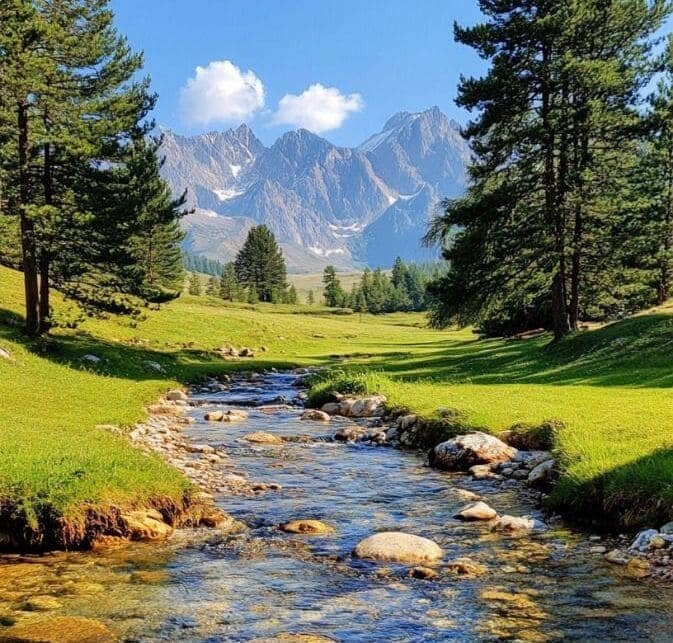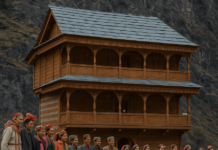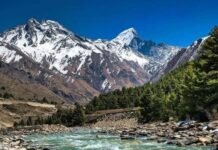This page contains important Geography-related questions and answers about Himachal Pradesh. It is specially designed for students and competitive exam aspirants. The content covers major rivers, mountains, climate, valleys, and other geographical facts of the state. All questions are written in simple and easy English. This will help you quickly understand and remember the key points. Stay connected for more useful GK content!
What is the total geographical area of Himachal Pradesh?
Himachal Pradesh covers a total area of about 55,673 square kilometers. Situated in the western Himalayas, it is a land of towering mountains and scenic beauty. The terrain includes forests, valleys, rivers, and snow-covered peaks.
Which district of Himachal Pradesh receives the highest rainfall?
Kangra district receives the highest rainfall in the state. The Dhauladhar range influences the monsoon, bringing heavy showers. Due to this rainfall, the area has lush greenery and fertile agricultural land.
Name the highest mountain peak in Himachal Pradesh.
Reo Purgyil, located near the Tibet border in Kinnaur district, holds the title of the highest mountain peak in Himachal Pradesh. The peak is part of the Zanskar range and remains snow-covered throughout the year.
What is the elevation of Reo Purgyil, the highest peak in Himachal Pradesh?
Reo Purgyil stands at an elevation of 6,816 meters (22,362 feet) above sea level. It is the highest point in Himachal and offers a challenging climb for mountaineers. The region is remote and sparsely inhabited.
Which pass connects Lahaul to the Kullu Valley?
Rohtang Pass connects the Lahaul region to the Kullu Valley. Located at 3,978 meters, it remains closed during winter due to heavy snowfall. It has now been bypassed by the Atal Tunnel for year-round travel.
Name the famous lake located in the Chamba district.
Manimahesh Lake is the most famous lake in the Chamba district. Located at the base of the sacred Manimahesh Kailash, it offers breathtaking views. The lake is considered sacred and visited by pilgrims during the Manimahesh Yatra.
What is the literacy rate of Himachal Pradesh as per the latest census?
With a literacy rate of 82.80% as per the 2011 Census, Himachal Pradesh ranks among the most literate states in the country. The female literacy rate is also significantly higher in comparison to many other states.
In which district is the Great Himalayan National Park located?
The Great Himalayan National Park lies in Himachal Pradesh’s scenic Kullu district. It is a UNESCO World Heritage Site. The park is home to many rare species and offers eco-tourism and trekking opportunities.
Which is the longest river in Himachal Pradesh?
Flowing through Kinnaur and Bilaspur after entering from Tibet, the Sutlej is the longest river in Himachal Pradesh. Many hydroelectric projects have been built along its course.
Name the ancient trade route that passed through Himachal Pradesh.
The Silk Route and the Hindustan-Tibet Road were ancient trade routes passing through Himachal. These routes connected India to Tibet and Central Asia. They played a major role in cultural and commercial exchange.
Which Himachal district has no railway connectivity?
Lahaul and Spiti districts do not have any railway connectivity. Due to its remote and high-altitude location, transportation is limited to roadways. Harsh weather and terrain make infrastructure development difficult.
What are the main crops grown in Himachal Pradesh?
Major crops include wheat, maize, barley, and rice, along with fruits like apples, plums, and cherries. The state is also famous for cash crops like ginger and off-season vegetables in hilly regions.
Name two popular wildlife sanctuaries in Himachal Pradesh.
Renuka Wildlife Sanctuary in Sirmaur and Chail Sanctuary in Solan are well-known sanctuaries. These areas are teeming with biodiversity, sheltering leopards, barking deer, and a wide variety of birds. Both are tourist-friendly destinations.
In which year did Himachal Pradesh attain full statehood?
On January 25, 1971, Himachal Pradesh was granted statehood and became the 18th state of India. This day is celebrated as Himachal Statehood Day. Before that, it was a Union Territory formed after independence.
Who is known as the “Architect of Himachal Pradesh”?
Dr. Yashwant Singh Parmar is honored as the “Architect of Himachal Pradesh” for his visionary leadership. He led the movement for statehood and served as the first Chief Minister. His contributions shaped the political and social future of the state.
What is the state flower and state bird of Himachal Pradesh?
Himachal Pradesh’s state flower is the vibrant Pink Rhododendron, and its state bird is the rare and beautiful Western Tragopan, also known as Jujurana. Both are found in high-altitude forests and are symbols of Himachal’s rich biodiversity.
Which city is known as the “Apple Bowl of India”?
Famous for kickstarting apple cultivation in India, Kotgarh in Shimla has earned the nickname ‘Apple Bowl of the country’. It was here that apple cultivation began in the early 1900s. The region now contributes significantly to India’s apple production.
What is the traditional attire of women in Kinnaur?
Women in Kinnaur wear colorful woolen dresses with chubas, silver ornaments, and the traditional green Kinnauri cap. The attire is stylish and suitable for cold weather and reflects their rich cultural heritage.
Name the major languages spoken in Himachal Pradesh.
Languages spoken widely in the region include Hindi, Kangri, and various Western Pahari dialects. In tribal areas, Bhoti and Kinnauri
In which district is the Chandra Tal Lake located?
Lahaul and Spiti
Which mountain range separates Himachal from Tibet?
Zanskar Range
What type of climate is found in the Lahaul-Spiti region?
Cold Desert Climate
Which is the largest glacier in Himachal Pradesh?
Bara Shigri Glacier
What is the average elevation of Himachal Pradesh?
Around 1,200 meters to 6,816 meters above sea level







